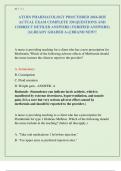Exam (elaborations)
Exam Guide Questions and answers compilation INF3720 - Human-Computer Interaction II (inf3720) Interaction Design, ISBN: 9781119020752
- Institution
- University Of South Africa (Unisa)
- Book
- Interaction Design
Past Exam papers questions and answers. Prescribed chapters summary. Everything you need to pass this erxam
[Show more]








